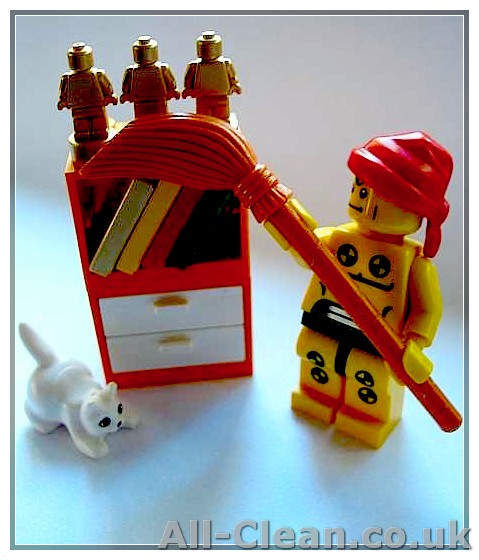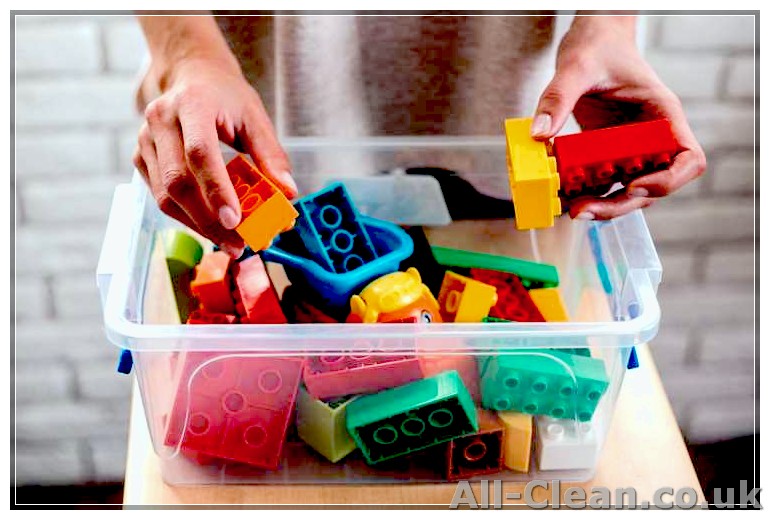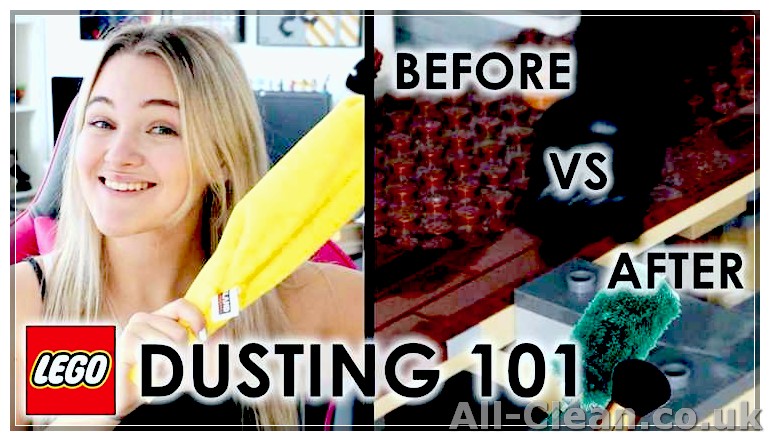
Legos are a favorite toy for kids of all ages. From toddlers who are just learning to stack the blocks to older kids who create intricate structures, Legos provide hours of entertainment. However, with all that use, Legos can quickly become dirty and collect dust and germs.
When it comes to cleaning Legos, many moms are unsure of the best approach. Should you use soap and water or a disinfectant? Will it damage the Legos? How do you ensure all the little pieces get clean? To answer these questions and more, we’ve put together a list of five tips to help you thoroughly clean your child’s Legos.
Tips for Cleaning Legos:
1. Sort and separate: Before you start cleaning, sort and separate the Legos by color, size, or type. This will make it easier to clean them and reassemble afterward.
2. Use a mesh bag for smaller pieces: Smaller Lego pieces, like lights or cables, can easily get lost during the cleaning process. To prevent this, place them in a mesh bag or a pillowcase and secure it tightly before washing.
3. Try the dishwasher: Believe it or not, Legos are dishwasher safe. Put them in a dishwasher-safe container or use a mesh bag and run them through a gentle cycle with lukewarm water. Remember to skip any heat options as excessive heat can warp the plastic.
4. Remove stains with a paste: For stubborn stains or grime, make a paste using water and baking soda. Apply it to the dirty surface and let it sit for a few minutes before wiping it off with a damp cloth. This will help remove any greasy or dirty residue.
5. Sanitize with a disinfectant: Lastly, to ensure your Legos are germ-free, sanitize them with a mild disinfectant. Mix one gallon of water with a small amount of white vinegar or a gentle soap-and-water mixture. Soak the Legos for a few minutes, then rinse them thoroughly and let them air dry.
By following these simple – yet important – steps, you can keep your child’s Legos clean and safe for play. Remember, it’s important to clean Legos regularly, especially during flu season or when they are displayed in areas where they collect dust. With the right approach and a little effort, your child’s Legos will always be germ-free and ready for their next building adventure!
- Regular Cleaning Routine
- Gentle Hand Washing Method
- Deep Cleaning Techniques
- 1. Transfer in a Mesh Bag
- 2. Wash in a Bucket
- 3. Scrub with a Toothbrush
- 4. Rinse Under Running Water
- 5. Disinfect with a Vinegar Solution
- Sanitizing and Disinfecting
- Proper Drying and Storage
- 1. Air Dry Your LEGO Pieces
- 2. Separate and Sort
- 3. Store LEGO Pieces in a Dry and Dust-Free Environment
- 4. Use Ziplock Bags or Plastic Containers
- 5. Consider Using a LEGO Storage System
- How to Sanitize and Disinfect LEGOs
- 1. Soap and Water
- 2. Disinfectant Wipes
- 3. Soaking in a Disinfecting Solution
- Additional Tips
Regular Cleaning Routine
Says you, if you want to keep your kids’ LEGOs clean and free of dust and germs, it’s important to establish a regular cleaning routine. Here’s a simple step-by-step guide to help you get started:
- First, gather all the LEGO bricks and pieces that need to be cleaned. It’s a good idea to do this in the bathroom or any other area with a hard floor, as LEGO pieces tend to be slippery when wet.
- Next, prepare a cleaning solution. You can either use a mild dish soap or a gentle disinfectant cleaner. Mix a small amount of the cleaner with lukewarm water in a dishpan or a large basin.
- Submerge the LEGO pieces in the cleaning solution and let them soak for a few minutes. This will help to loosen any dirt or grime that may be stuck on the surface.
- After soaking, use a soft-bristled brush or a toothbrush to gently scrub the LEGO pieces. Pay extra attention to any crevices or hard-to-reach areas.
- Rinse the pieces thoroughly with clear water to remove any leftover cleaner. It’s important to remove all traces of cleaner to avoid any potential skin irritation. You can use a colander or a strainer to make rinsing easier.
- Once the LEGO pieces are rinsed, lay them out on a towel or a drying rack to air dry. Make sure to place them in a well-ventilated area to speed up the drying process.
- If you want to disinfect the LEGO pieces, you can use disinfectant wipes. Simply wipe each piece thoroughly with the wipes and let them air dry.
Following these steps will ensure that your kids’ LEGO toys are not only clean but also germ-free. It’s a good idea to set aside some time every few months to give the LEGOs a more thorough cleaning. This can be done by submerging the LEGO pieces in a mixture of mild dish soap and lukewarm water and letting them soak for a longer period of time. After soaking, scrub them gently with a brush and rinse well. Air dry the pieces to restore them to their original condition.
Gentle Hand Washing Method
Even though it may seem time-consuming, hand washing your child’s LEGO toys is a gentle and effective way to clean them. Sarah Peterson, a mom of three and LEGO enthusiast, says that this method is her favorite and highly recommends it.
To do a regular hand washing, start by gathering all the LEGO bricks you want to clean. Fill a basin or sink with warm water and add a small amount of mild dish soap. Sarah, just like many other moms, suggests using the dish soap version that doesn’t have any added fragrance or harsh chemicals to avoid any irritation.
Lightly wash the LEGO bricks in the soapy water, using a soft cloth or sponge. Be gentle, especially with smaller or more delicate pieces. Avoid using any abrasive materials that can scratch the plastic surfaces.
If you have any LEGO pieces with cables or electronic components, remove them before washing. It’s important not to soak or submerge these parts in water to prevent any damage. Sarah recommends sanitizing these components separately with a disinfectant wipe or cleaning them with a slightly damp cloth.
For heavy dirt or grease stains, Sarah suggests making a cleaning paste using water and baking soda. Gently rub the paste onto the LEGO bricks and rinse thoroughly. This method can be effective for really stubborn stains that regular washing might not remove.
When it comes to drying the LEGO bricks, Sarah advises using a clean towel or letting them air dry. Avoid using a hair dryer or any source of heat, as high temperatures can warp or damage the plastic.
Overall, the hand washing method is a must-read for LEGO moms who want to keep their children’s favorite toys clean and sanitized. It’s a safe and gentle way to remove dust, germs, and other contaminants while preserving the integrity of the LEGO bricks.
Deep Cleaning Techniques
When it comes to cleaning your kids’ LEGO toys, sometimes a simple wash isn’t enough. Deep cleaning techniques are needed to ensure that the toys are thoroughly sanitized and free from dirt and germs. Here are five deep cleaning techniques to follow:
1. Transfer in a Mesh Bag
Before you start the deep cleaning process, transfer all the LEGO pieces into a mesh bag. This will prevent any small parts from getting lost during the cleaning.
2. Wash in a Bucket
Fill a bucket with warm water and add a disinfectant or gentle soap. Stir the water to create a soapy solution.
- Tip: Only clean one set of LEGO toys at a time to avoid mixing up the pieces.
3. Scrub with a Toothbrush

Use a toothbrush to scrub each LEGO piece, paying special attention to any areas with stickers or heavy dirt. Make sure to clean both the top and bottom of each piece.
4. Rinse Under Running Water
Rinse the LEGO pieces under running water to remove any soap residue. Make sure to rinse until the water runs clear.
5. Disinfect with a Vinegar Solution
To disinfect the LEGO pieces, create a vinegar solution by mixing one gallon of water with one cup of vinegar. Soak the LEGO pieces in the solution for 15-20 minutes.
- Tip: This vinegar solution is a great alternative for moms with toddlers who may put LEGO pieces in their mouths.
Following these deep cleaning techniques will ensure that your kids can continue to have fun and play with their LEGO toys in a clean and germ-free environment. It’s important to clean and disinfect LEGO toys regularly, especially during flu seasons or when kids are sick. With a little effort, you’ll have clean and sanitized LEGO sets that not only look good but also keep your kids healthy.
Sanitizing and Disinfecting
Sometimes, regular cleaning is not enough, especially when it comes to sanitizing and disinfecting your child’s LEGO collection. With excessive use and play, LEGO bricks and sets can become breeding grounds for germs and bacteria, making it vital to keep them clean and safe.
While water can be used to clean LEGO bricks, it is important to note that excessive exposure to water can damage them. Instead, you can fill a dishpan or sink with lukewarm water and use a mild soap-and-water solution to clean the bricks. Avoid using bleach or other harsh chemicals, as they can damage or discolor the bricks.
- Start by stirring the bricks in the soapy water to loosen any dirt or grime that may be on them.
- Using a soft-bristled brush or sponge, gently scrub the surface of the LEGO bricks to remove any stuck-on debris.
- Rinse the bricks thoroughly with clean water to remove any soap residue.
- To ensure the bricks are completely dry, you can either let them air dry or use a clean towel to dry them manually.
If you want to take sanitizing and disinfecting to the next level, you can use a solution of white vinegar and water. Fill a dishpan or sink with a mixture of equal parts white vinegar and water and let the LEGO bricks soak for about 15-20 minutes. This will help kill any germs or bacteria that may be present on the bricks.
For those who are short on time or have larger LEGO sets, the dishwasher can be a convenient option. Place the LEGO bricks in a mesh bag or a dishwasher-safe container and run them through a gentle cycle without any detergent. However, be sure to remove any loose or small parts that may get lost or damaged in the dishwasher.
Here are some additional tips to ensure sanitizing and disinfecting LEGO sets is a breeze:
- If possible, try to wipe down LEGO sets regularly with a disinfectant wipe to keep them clean and free from germs.
- For those who have LEGO sets on display, consider using a clear plastic covering to protect them from excessive dust and germs.
- To remove any sticky residue or grease from LEGO bricks, you can use a small amount of rubbing alcohol or a specialized adhesive remover.
- If you’re a busy mom or dad, involve your kids in the cleaning process. Make it a fun activity by creating a “LEGO cleaning station” and encourage them to help clean their LEGO sets.
By following these sanitizing and disinfecting tips, you can ensure that your child’s LEGO collection stays clean, safe, and free from germs. So don’t let dirt and dust get in the way of their next building adventure!
Proper Drying and Storage
When it comes to cleaning and maintaining your kids’ LEGO toys, proper drying and storage are essential to keep them in optimal condition. Follow these tips to ensure your LEGO pieces are clean and ready for play:
1. Air Dry Your LEGO Pieces
After washing your LEGO pieces, it’s important to let them air dry completely before storing them. Placing wet LEGO pieces in a container can create a breeding ground for mold and bacteria. Allow the pieces to air dry on a clean towel or drying rack.
2. Separate and Sort
Besides washing, sorting your LEGO pieces is also essential for efficient drying. Separate larger pieces from smaller ones to ensure that all surfaces are exposed to air. This will help speed up the drying process and prevent any moisture from getting trapped between the pieces.
3. Store LEGO Pieces in a Dry and Dust-Free Environment

Once your LEGO pieces are completely dry, it’s time to store them. Find a dry and dust-free location to keep the LEGO pieces. Avoid storing them in areas that are prone to moisture or direct sunlight, as these conditions can damage the bricks and cause them to fade over time.
4. Use Ziplock Bags or Plastic Containers
To prevent dust and dirt from accumulating on your LEGO pieces, store them in ziplock bags or plastic containers. This will keep them protected and make it easier to find specific pieces when needed. Label each bag or container to easily identify the contents.
5. Consider Using a LEGO Storage System
If you have a large collection of LEGO bricks, investing in a LEGO storage system can help keep your pieces organized and easily accessible. These systems often come with separate compartments for different types of LEGO pieces and can be stacked or mounted on a wall for space-saving.
By following these proper drying and storage tips, you can ensure that your kids’ LEGO toys remain clean, dust-free, and ready for endless building and imaginative play!
How to Sanitize and Disinfect LEGOs
When it comes to cleaning LEGOs, there are a few things to keep in mind. While dust is the most common problem, LEGOs can also harbor germs and dirt, especially if they are played with by children. Regular cleaning can help keep the toys in good condition and ensure a safe play environment. Here are some ways to sanitize and disinfect LEGOs:
1. Soap and Water
The easiest and most common way to clean LEGOs is by using mild soap and water. Fill a bucket with warm water and add a few drops of mild soap. Remove all visible dirt and dust from the bricks, then soak them in the soapy water for a few minutes. Use a soft brush or cloth to gently scrub the bricks, paying attention to any crevices. Rinse the LEGO bricks thoroughly with clean water and allow them to air dry.
2. Disinfectant Wipes

If you want a quick and convenient way to disinfect LEGO bricks, disinfectant wipes are a great option. Look for wipes that contain antibacterial properties to effectively kill germs. Simply wipe each brick with the disinfecting wipe, focusing on any areas that are likely to be touched by hands. Allow the bricks to air dry after disinfecting.
3. Soaking in a Disinfecting Solution
If you’re dealing with LEGO sets that have a lot of dust and dirt accumulated over time, soaking them in a disinfecting solution may be the best approach. Fill a bucket with a mixture of warm water and a mild disinfectant solution. Place the LEGO bricks in the solution and allow them to soak for about ten minutes. Gently scrub the bricks with a soft brush or cloth to remove any remaining dirt or grime. Rinse the bricks thoroughly with clean water and let them air dry.
Additional Tips
- Use a mesh bag to wash small LEGO pieces in the dishwasher. This will prevent them from getting lost or damaged during the cleaning process.
- If you have LEGO sets on display and want to sanitize them without disassembling, use a gentle disinfectant spray and wipe them down with a cloth.
- Avoid excessive soaking or using harsh chemicals, as they may cause the LEGO bricks to become discolored or damaged.
- For those who prefer a more eco-friendly approach, white vinegar can be used as an alternative to disinfectant solutions.
- Always follow the manufacturer’s care instructions, especially for LEGO sets with electronic components or delicate pieces.
By regularly cleaning and sanitizing your LEGO bricks, you can ensure that they are free from dirt, germs, and other harmful substances. This will not only result in a cleaner play environment but also prolong the lifespan of your LEGO sets.








